
The southern platyfish, common platy, or moonfish is a species of freshwater fish in family Poeciliidae of order Cyprinodontiformes. A live-bearer, it is closely related to the green swordtail and can interbreed with it. It is native to an area of North and Central America stretching from Veracruz, Mexico, to northern Belize.
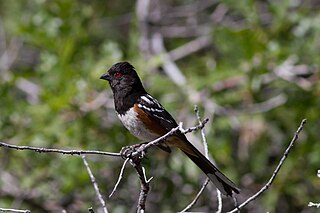
The spotted towhee is a large New World sparrow. The taxonomy of the towhees has been debated in recent decades, and until 1995 this bird and the eastern towhee were considered a single species, the rufous-sided towhee. Another outdated name for the spotted towhee is the Oregon towhee. The call may be harsher and more varied than for the eastern towhee.

The tiger quoll, also known as the spotted-tail quoll, the spotted quoll, the spotted-tail dasyure, native cat or the tiger cat, is a carnivorous marsupial of the quoll genus Dasyurus native to Australia. With males and females weighing around 3.5 and 1.8 kg, respectively, it is the world's second-largest extant carnivorous marsupial, behind the Tasmanian devil. Two subspecies are recognised; the nominate is found in wet forests of southeastern Australia and Tasmania, and a northern subspecies, D. m. gracilis, is found in a small area of northern Queensland and is endangered.

Dermestidae are a family of Coleoptera that are commonly referred to as skin beetles. Other common names include larder beetle, hide or leather beetles, carpet beetles, and khapra beetles. There are over 1,800 species described.
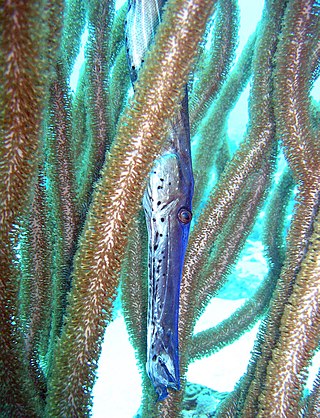
Aulostomus maculatus, the West Atlantic trumpetfish, is a long-bodied fish with an upturned mouth. It often swims vertically while trying to blend with vertical coral, such as sea rods, sea pens, and pipe sponges.
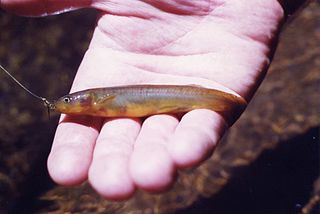
The Galaxiidae are a family of mostly small freshwater fish in the Southern Hemisphere. The majority live in Southern Australia or New Zealand, but some are found in South Africa, southern South America, Lord Howe Island, New Caledonia, and the Falkland Islands. One galaxiid species, the common galaxias, is probably the most widely naturally distributed freshwater fish in the Southern Hemisphere. They are coolwater species, found in temperate latitudes, with only one species known from subtropical habitats. Many specialise in living in cold, high-altitude upland rivers, streams, and lakes.
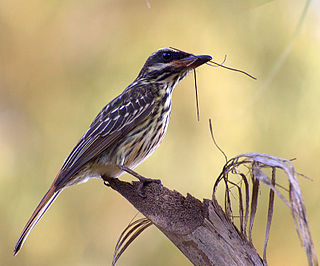
The streaked flycatcher is a passerine bird in the tyrant flycatcher family.
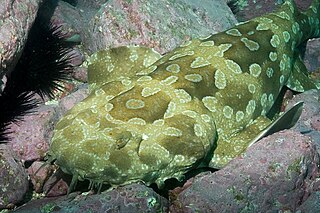
The spotted wobbegong is a carpet shark in the family Orectolobidae, endemic to Australia. It is a large, robust species, typically reaching 150–180 centimetres (59–71 in) in length. Coloured green, yellow, or brown, it has distinctive O-shaped spots throughout its body. It is nocturnal, resting at day and feeding on fish and invertebrates at night. An ovoviviparous species, the spotted wobbegong gives birth in the spring, during which time males can act aggressively towards other males and females. It has been known to bite humans, sometimes unprovoked, which can produce severe wounds. The species is fished commercially in Australia, but it is not severely threatened. It is listed as a least-concern species on the IUCN Red List.

The narrowtail catshark is a catshark of the family Scyliorhinidae, found off the coasts of Honduras and Nicaragua, between latitudes 18° N and 10° N, at depths between 190 and 410 m. It can grow up to a length of 35 cm (14 in). The reproduction of this catshark is oviparous.

The orange chromide is a species of cichlid fish that is endemic to freshwater and brackish streams, lagoons and estuaries in southern India and Sri Lanka. It is also known as pallathi in Malayalam. The species is popular with fishkeeping hobbyists, and is kept frequently in aquariums. The species is part of the family Cichlidae and is included in subfamily Etroplinae. The orange chromide reaches a length of up to 8 cm (3.1 in).

The spotted forktail is a species of bird in the family Muscicapidae. It is found in the Himalayas and the hills of Northeast India, Bangladesh, Myanmar, and southern China including Yunnan. Birds of this species are 25 cm with a long tail. The sexes are alike, having a white forehead and a black crown and nape, a black back spotted white, and a broad white wing bar. The tail is deeply forked, graduated black and white. The white spotted back easily identifies this species from other similar sized forktail. Its call is a shrill, screechy KREE, mostly given in flight; it also makes some shrill, squeaky notes while perched. It breeds mostly at 1200–3600 m, and descends to about 600 m in winter. Its natural habitat is subtropical or tropical moist montane forests, where it is found in boulder-strewn torrents, forest streams, and roadside canals.
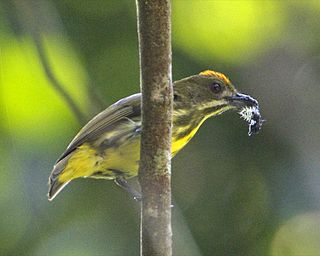
The yellow-breasted flowerpecker is a species of bird in the family Dicaeidae. It is found in Brunei, Indonesia, Malaysia, Myanmar, Singapore, and Thailand. Its natural habitats are subtropical or tropical moist lowland forest and subtropical or tropical moist montane forest.

Chlidanotinae is a subfamily of moths in the family Tortricidae.

The Cochylini are a tribe of tortrix moths. It used to be classified as the subfamily Cochylinae.
Pentacitrotus is a genus of moths belonging to the subfamily Tortricinae of the family Tortricidae.

The Euliini are a tribe of tortrix moths.
Tumidotheres maculatus is a species of crab that lives commensally or parasitically in the mantle cavity of molluscs. It is found along much of the western Atlantic Ocean and was first described by Thomas Say in 1818.
Pentacitrotus leechi is a species of moth of the family Tortricidae. It is found in central China and Taiwan.

Pentacitrotus tetrakore is a species of moth of the family Tortricidae. It is found in Taiwan.

Epinephelus maculatus, the highfin grouper, blackfin cod or brown-spotted rock-cod, marbled rock-cod or spotted grouper, is a species of marine ray-finned fish, a grouper from the subfamily Epinephelinae which is part of the family Serranidae, which also includes the anthias and sea basses. It is found in the Indo-Pacific region.
















